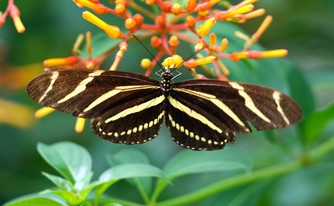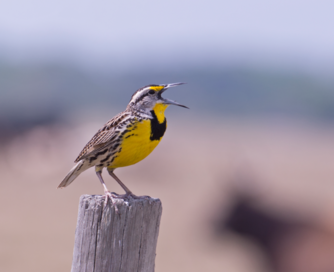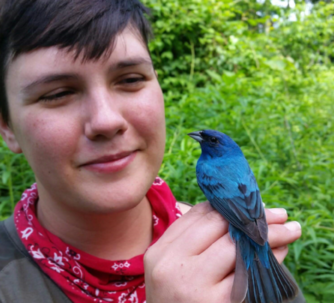 A zebra longwing feeds at a firebush in Chinsegut Wildlife and Environmental Area’s native plant garden. Photo by Travis Blunden, FWC.
Last month we visited Chinsegut Wildlife and Environmental Area (WEA) in Hernando County, six miles north of Brooksville. This Trail site is made up of two tracts connected by the two-mile Prairie to Pines Trail, and offers plenty of hiking through sandhill, longleaf pine and freshwater wetland habitat. During our visit, we met with Conservation Center director Gina Long to find out what this WEA has to offer. A trip along hiking trails and boardwalks offered glimpses of Northern Bobwhite, Sandhill Crane, Red-headed Woodpecker, Black-and-white Warbler and white-tailed deer, but by far the most abundant and stunning creatures we saw were the butterflies. The Center's native plant garden hosted clouds of zebra longwings, gulf fritillaries and pipevine swallowtails. Wild passion vine along the trails attracted even more species, including Horace's duskywing and long-tailed skipper. Over 75 species of butterfly have been recorded here so Chinsegut is an excellent destination for anyone working on their 2019 butterfly Big Year!
The Conservation Center Tract has an impressive center and classroom, a native plant garden, bird feeders and several miles of trails. The parking lot off Lake Lindsey Road is open to the public on Fridays and Saturdays from 8:00 a.m. to 2:00 p.m., but visitors may hike in from the trailhead on US 41 during any daylight hours. You are also allowed to park at the trailhead along Old Crystal River Road to access over two miles of hiking trail loops on the Big Pine Tract.
The Conservation Center at Chinsegut WEA offers presentations and hands-on activities for children and adults throughout the year. See a schedule of events!
Conservation Center
Address: 23212 Lake Lindsey Road, Brooksville, FL 34601
Hours: Friday and Saturday 8:00 a.m.-2:00 p.m.
Hiking trails
Big Pine Tract entrance: 12060 Old Crystal River Rd, Brooksville, FL 34601
Route 41 entrance: Intersection of N Broad St and Snow Memorial Highway, Brooksville, FL 34601
Hours: Daylight
Trail Map
 The beautiful whistling song of the Eastern Meadowlark is a common sound in fields and pastures across the eastern United States. Photo by Andy Wraithmell, FWC.
Songs and calls of birds—the rattling cry of a Sandhill Crane, the seemingly endless repertoire of a Northern Mockingbird, the peaceful, lilting song of a Chuck-will’s-widow—are integral to the rich tapestry of nature’s sounds. This month we explore how and why birds sing.
Birders often distinguish between two types of sounds birds make. The first group, calls, are usually short, simple sounds birds can use to communicate a warning or let other birds know where they are. Where birds show their real virtuosity, however, is in songs—complex vocalizations that males typically use to attract mates or defend territories in the breeding season. Usually when you hear a bird singing it is a male - however, the females of some species like Northern Cardinals and Red-winged Blackbirds are also beautiful songsters. Song repertoire can vary greatly from species to species. Some species have one or two songs, while others (like Northern Mockingbirds or Brown Thrashers) can have a repertoire in the hundreds. The more variety for these species, the better—potential mates and rivals can get tired of hearing the same song all breeding season in the same way that humans get tired of the same song played over and over on the radio!
One of the secrets to bird song is a special organ called the syrinx that sits at the base of a bird’s trachea, or windpipe. This is the bird’s voice box and, like the human larynx, it produces sound when air from the lungs is passed over tightened membranes. The base of the syrinx is bifurcated, or split, and birds can control the two sides of the organ independently–almost as if they had two voices! Fine control over the two sides enables them to execute some truly incredible performances. Some birds, like the canary, rapidly alternate between the two sides to produce an incredibly fast trill. Others, like the Wood Thrush, can sing different notes—in differing patterns—at the same time!
Birds are born with the instruments they need to sing beautifully—but what about their repertoire? Do they break out of the egg with the knowledge of their species’ songs, or do they learn from parents? Turns out the answer is a little bit of both. By studying birds raised in acoustic isolation, scientists have learned that certain birds including doves, cowbirds, and some flycatchers know their songs innately. In the large group of birds known as the oscine songbirds, however, there is at least some learned component of song. While some species can learn songs throughout their lives, it is much more common for birds to learn when they are young. Just like it is much easier for people to learn a new language as children rather than adults, birds have a critical window of time when they practice and perfect their songs.
Birdsong is fascinating to learn about, and can also be a practical tool for birders and researchers. Identifying birds by ear can be daunting at first, but as with any new skill, patience and persistence are key. Start by taking an inventory of what you do know, and you may be surprised! Even a backyard birder has probably learned the “chickadee-dee-dee” alarm call for which the common feeder bird is named, the harsh cry of a Blue Jay, and the plaintive coo of a Mourning Dove. Mnemonic devices can also help in learning bird calls–it’s easy to remember the “who cooks for you, who cooks for you-all” of a Barred Owl or the “teakettle, teakettle, teakettle” of a Carolina Wren. There are many apps, recordings, and online resources that can help in your quest to master birding by ear, but the best way to learn, as always, is to get outside and practice!
The Great Florida Birding and Wildlife Trail is a program of the Florida Fish and Wildlife Conservation Commission’s Public Access Services Office. Meet some of the staff who help keep the trail up and running!
 Liz Schold is the coordinator of the Great Florida Birding and Wildlife Trail. While working in an avian genetics lab in college, she had the opportunity to get out of the laboratory and do field work with a breeding colony of Leach’s Storm Petrels. “I’d always been excited about nature and the outdoors,” she says, “but those summers working with seabirds sealed the deal–I became a certified bird nerd, and there was no going back.” She has since had the pleasure of studying Florida Scrub-Jays, Great Crested Flycatchers, Cerulean Warblers, Golden-winged Warblers, and - her favorite - Prothonotary Warblers. Liz completed her master’s degree in biology at Virginia Commonwealth University in 2018 and relocated to Tallahassee to work for the FWC. Here, she promotes and facilitates birding and wildlife viewing across the state by developing informative materials, maintaining trail infrastructure and engaging new audiences. In her free time, Liz likes to bake, explore new places and learn more about the flora and fauna of the sunshine state.
 Travis Blunden is the coordinator of the Wings Over Florida program. While new to this position, he is not new to the FWC, having worked in the land management section for 11 years—first as a biologist at Half Moon Wildlife Management Area and then as the Northeast Region’s Conservation Biologist. “I’ve had the opportunity to work with so many different species including Florida Scrub-Jays, Kestrels, Red-cockaded Woodpeckers, Florida mice and gopher tortoises,” says Travis. He received his master’s degree in Wildlife Ecology from the University of Florida in 2010. Prior to that he interned with the Audubon Corkscrew Swamp Sanctuary and worked for the Florida Park Service. Travis and his wife, Claire (who also works for the FWC), recently moved to Tallahassee and are quickly learning the area. An experienced naturalist, Travis enjoys being outside and sharing the natural world with others, especially his young daughter. In his free time, he likes to discover new places, fish, hunt, and enjoy wildlife in his own backyard.
Upcoming Events
August 20 - Breakfast with the Birds Lecture – Water Quality and Seabirds (Naples)
August 24 - Scrub-Jay Trailday (Clermont)
August 25 - Guided Bird Walk at Anastasia State Park (St. Augustine)
September 7 - Scrub-Jay Trail Orientation (Clermont)
September 10 - eBird Training (St. Augustine)
Check out the events page of our website for more events across the state!
Do you know about any other bird- or wildlife-related events going on in Florida? Help spread the word by letting us know! Send in the times, dates, locations and contacts to wildlifeviewing@myfwc.com for posting on the Great Florida Birding and Wildlife Trail website.
Events must be related to birds or other wildlife and must be open to the public. Examples include interpretive programming, summer camps and family programs.
|